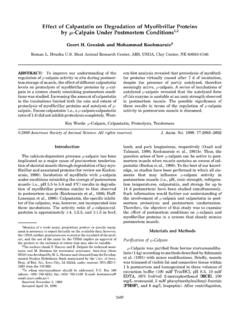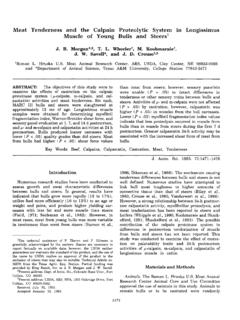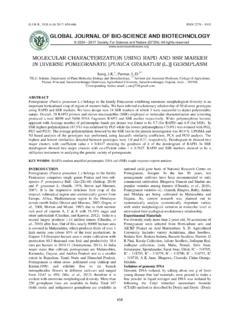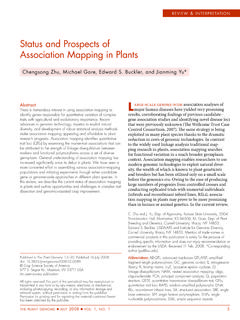Transcription of ARS procedures and best management practices for ...
1 1 ARS procedures and best management practices for genetically engineered traits in plant germplasm and breeding lines v. 73, 14 Feb. 2018 Introduction In November 2012, the USDA Advisory Committee on Biotechnology and 21st Century Agriculture (AC 21; s ee the acronym glossary) issued its report Enhancing Coexistence: A Report of the AC21 to the Secretary of Agriculture. The AC 21 made three specific recommendations regarding the need for Best management practices (BMPs) to monitor and maintain the purity of publicly held plant germplasm : For every plant species with commercially available or new GE [genetically engineered] varieties on the market, the USDA should assure that a credible plan is implemented to monitor and maintain the purity of publicly held germplasm .
2 Each plan should include BMPs for maintenance of purity, and should include measures to: Determine the presence of plants with the GE trait or traits in publicly held germplasm stocks; Conduct ongoing monitoring of unintended presence in germplasm stocks, sufficient to detect any significant increase in its frequency in germplasm and breeding lines; Address what to do when unintended GE presence is detected in such germplasm stocks. In response, USDA/ARS has updated and refined its procedures and BMPs for maintaining true-to-type plant germplasm samples (also termed accessions ) and breeding stocks, and for assuring compliance with all relevant regulatory requirements associated with plants incorporating genetically engineered (GE) traits.
3 Furthermore, it is particularly important that such an update occur now, because updated procedures and BMPs should be in place before USDA/ARS begins to incorporate currently proprietary--but soon to be public domain-- varieties or enhanced populations with GE traits into its crop breeding programs and to distribute them from its genebanks. USDA/ARS genebanks and breeders must continue to generate high-quality, true-to-type materials that ensure repeatable research, uninterrupted breeding progress, and maintain the Agency s scientific reputation. These procedures and BMPs will be subject to periodic reviews and updates. Background for the updated procedures and BMPs The updated procedures and BMPs presented in this document were developed by a team of USDA/ARS researchers, germplasm curators, line managers, and National Program Leaders to provide Agency-wide guidance for handling adventitious presence ( AP , the low frequency, unintentional, and incidental occurrence of unwanted genetic off-types) of GE traits in conventional USDA/ARS crop breeding stocks and germplasm accessions, and also management of USDA/ARS varieties that do incorporate GE traits.
4 They draw on existing guidelines, 2 practices and procedures to manage material incorporating GE traits and to avoid AP of unintended GE traits, such as those described in BIO 2013; CropLife International 2014; Excellence in Stewardship 2008; and IPGRI 2004. They encompass five major Elements for guiding USDA/ARS stewardship of germplasm accessions and breeding stocks. USDA/ARS germplasm curators, plant breeders, and researchers are responsible for implementing these updated procedures and BMPs. It cannot be over-emphasized that effective implementation of and adherence to BMPs are critical to maintaining the genetic integrity of USDA/ARS germplasm accessions and breeding stocks.
5 Mitigation procedures (see Element 4 below) are designed to correct inadvertent occurrences after the fact rather than to compensate for BMPs that are lacking or not followed scrupulously. Conversely, adhering to BMPs assiduously can enable quality problems to be diagnosed more effectively when they occur and simplify mitigation procedures , including diagnostic seed testing. Furthermore, consultation with local growers, experiment station personnel, and neighboring seed production operations can be critical for successful BMP implementation. In the context of USDA/ARS genebanks and breeding programs, seed testing (see BMP 2 below) is complicated by numerous technical, logistical, financial and practical challenges.
6 Although USDA/ARS personnel have always aspired to produce accessions and breeding lines as true-to-type as possible, new, sensitive and accurate detection methods for some GE traits necessitate a reconsideration of tolerance levels for off-types. This is especially the case for AP of GE traits. In general, standard seed testing procedures (see References at the end of the document) are designed to detect low frequencies of offtypes in large volumes of relatively genetically homogeneous seeds. Doing so requires testing many seeds, , more than 4,700 seeds to detect or more AP with a 95% probability. Importantly, at certain stages of development, USDA/ARS germplasm accessions and breeding lines can be highly heterogeneous genetically but encompass few seeds (100 or less).
7 Genebanks often first acquire accessions as samples of fewer than 100 seeds from field collections or donors. Several hundred or fewer seeds might be harvested from seed increases of germplasm accessions or some breeding stocks. Genebanks also distribute such samples to numerous requestors as batches of 100 or fewer seeds. Such small quantities of seeds restrict the degree of statistical precision and confidence levels of quality tests. Those tests are also usually destructive, and therefore can deplete the already small supply for these genetically diverse and valuable (sometimes irreplaceable) materials. Furthermore, seed testing for AP of GE traits can involve substantial additional costs to the comparatively small operational budgets for USDA/ARS genebanks and breeding programs.
8 Therefore, weighing those factors, for most cases USDA/ARS proposes testing for a <1% AP tolerance level for GE traits in conventional germplasm accessions and breeding lines as a balance between aspiration and practicality (see additional details under Elements 1-5 below). 3 Organization of this document This document is organized into five major components--termed Elements followed by a Glossary (p. 32), References (pp. 30-31), two Appendices (pp. 33-36), and two Figures (pp. 17-18). Element 1: Well-documented, reviewed, and accessible best management practices (BMPs) for maintaining seed purity in both USDA/ARS breeding and genebank programs (pp.)
9 5-19). Element 1 includes three specific BMPs. More BMPs can be added, as needed, to future versions of the document. o BMP 1: Conduct risk analyses of AP in the USDA/ARS National Plant germplasm System (NPGS) accessions or USDA/ARS breeding stocks. (pp. 5-15) The results of risk analyses for AP are presented for five of the most important major U. S. crops with substantial acreage of varieties with GE traits: alfalfa, cotton, maize, soybean, and sugarbeets. These results comprise the largest section of this document. Risk analyses for additional crops can be added to future versions of the document. o BMP 2: Assure genetic integrity. ( ) Based on the preceding risk analyses, procedures for assuring the genetic integrity of germplasm and breeding stocks are described, including tolerance levels for AP, and seed management practices .
10 O BMP 3: Document requirements and procedures . (p. 19) The BMPs must be adequately documented to ensure their implementation and measure their effectiveness. Element 2: Testing for purity at critical control points ( ). Testing for purity is such an important aspect for ensuring overall seed quality that it is highlighted here as a separate Element 2. Figures 1 and 2 diagram the relationships among the critical control points and testing procedures . Appendix 2 (pp. 35-36) includes details for recommended testing and sampling techniques. Element 3: Mandatory purity testing of new USDA/ARS varieties or enhanced germplasm prior to formal release (p.)
















